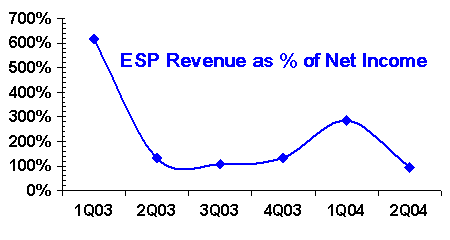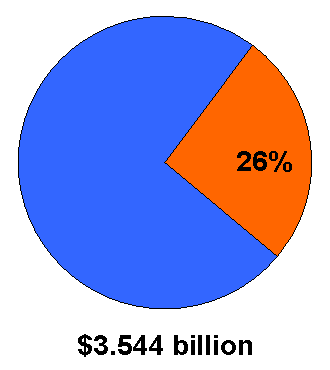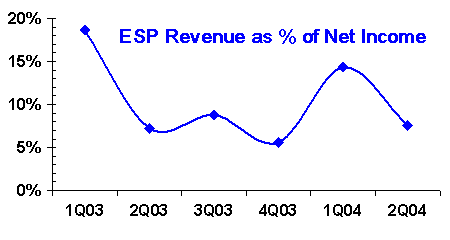Extended Warranty Profits:
For many manufacturers, the sale of extended warranties contributes heavily to net income. But only a handful of companies have made the financial disclosures needed to figure out how important it really is to them.
As we continue our multi-week tour of the extended warranty industry, it's time to take a closer look at the manufacturers themselves. Whether they call them extended warranties, service contracts, or extended service plans, one things seems certain. These contracts are a major source of profits, as we shall show through a closer examination of seven manufacturers in four different industries.
In the product warranty sector, thanks to the financial scandals of Enron, WorldCom, and others, the Financial Accounting Standards Board two years ago handed down FASB Interpretation No. 45: "Guarantor's Accounting and Disclosure Requirements for Guarantees, Including Indirect Guarantees of Indebtedness of Others." FIN 45 mandated how manufacturers should detail their warranty expenditures in all annual and interim financial statements. Unfortunately, there is no equivalent governing the disclosures of extended warranty contract sales.
Accounting for Extended Warranties
FASB Technical Bulletin 90-1, "Accounting for Separately Priced Extended Warranty and Product Maintenance Contracts," requires companies to defer the full recognition of their extended warranty revenue at the outset, and then to recognize it in stages on a straight-line basis over the life of the contract. But there isn't any mandate that these figures should actually be disclosed publicly and separately from other non-operating sources of income such as interest, finance, mortgage, or investment income.
Most manufacturers seem content to bury their extended warranty financial figures in the "other" category, which would seem appropriate if they represented a miniscule slice of their total revenue -- like the interest they earn on their bank balances. But after taking a look at the books of seven manufacturers who make more detailed extended warranty disclosures, it appears that these contracts account for a significant slice of net income -- anywhere between 10% and 100% is typical. That is not what's supposed to go in the "other" category.
During the eighteen months between Jan. 1, 2003 and June 30, 2004, for instance, extended warranty revenue represented between 95% and 617% of the net profits of Eastman Kodak Co. In other words, throughout the period the money they were losing through the sale of office equipment and photographic supplies was more than made up by the amount they earned from the sale of extended warranties. During the first quarter of 2003, the company reported just $12 million in net income, and $74 million in extended warranty revenue, meaning that without the income from these contracts the company would have declared a net loss during the period. Here's a chart showing the relationship between extended warranty revenue and net income.
Eastman Kodak Co.
Extended Warranty Revenue
as a Percentage of Net Income
Jan. 1, 2003 to June 30, 2004

Source: Warranty Week from SEC documents
As the chart shows, the only time in recent history that Kodak made less from extended warranties than it reported in net income was during the second quarter of 2004, when it reported net income of $182 million and extended warranty revenue of $173 million over the first six months of the year. At all other times, extended warranty revenue outpaced net income by a significant margin. It would not be inaccurate to call Eastman Kodak an insurance company that also sells cameras. Or to put it more accurately, Eastman Kodak sells cameras and office equipment in order to sell insurance policies for those products.
Of the top 50 manufacturers, Kodak was by far the most extreme case. However, there may be others who are simply choosing not to disclose how much of their service revenue comes from the sale of extended warranties. Unlike with product warranties, manufacturers such as Kodak are not required to provide the details that they do. But as long as they do, we might as well put them into perspective.
There also seem to be a few insurance companies that also manufacture computers. Dell Inc., Apple Computer Inc., and Gateway Inc. are the three that provide details on extended warranty sales, but it's highly likely that IBM, Sun, Hewlett-Packard, Sony, Acer, Toshiba, and others are also enjoying significant profits through their sale of insurance policies. In fact, in an Aug. 20 article, the Motley Fool said "Dell's business is becoming almost as much about insurance as it is about computers."
First, let's take a closer look at Dell. During the fiscal year ending Jan. 30, 2004, the company reported $3.544 billion in operating income (before taxes). It also reported the amortization of $912 million in deferred revenue gained through the sale of extended warranties. That's a long-winded term that basically equates to extended warranty revenue. And if our analysis is correct, such revenue passes directly to the bottom line. In other words, of the $3.544 billion in operating income, $912 million or 26% came from extended warranties, and $2.632 billion or 74% came from the sale of systems, software, and other services.
Dell Inc.
Extended Warranty Revenue
as a Percentage of Net Income
Jan. 31, 2003 to Jan. 30, 2004

Source: Warranty Week from SEC documents
Over the past six quarters, the ratio for Dell has varied from 24% to 30%. During the company's first fiscal quarter of 2005, it reported $288 million in recognized extended warranty revenue and $966 million in operating income, giving it a 29.8% ratio. But believe it or not, Dell wasn't even the most extreme example we found in the computer industry. That would be Apple Computer.
During the fiscal year ended Sept. 27, 2003, Apple reported $69 million in net income, and $30 million in recognized extended warranty revenue -- a 43% ratio. In the chart below, the red portion represents extended warranty revenue and the blue represents all other income.
Apple Computer Inc.
Extended Warranty Revenue
as a Percentage of Net Income
Sept. 27, 2002 to Sept. 27, 2003

Source: Warranty Week from SEC documents
Now the first thing our accounting-oriented readers must be saying is you can't mix revenue and income like that. But you can if you assume that what's called recognized revenue from extended warranty contract sales comes as pure profit. It represents the amount left over after all claims have been paid and all overhead covered. In other words, in this case recognized revenue is just about the same thing as net profit, although recognized revenue is pre-tax and net profit is post-tax.
Depending upon a manufacturer's effective tax rate, anywhere between 70% and 100% of the recognized revenue eventually makes it to the bottom line. Kodak didn't pay any taxes last year -- it had a $66 million credit. So if we had used the pre-tax income number in the denominator, the company's $355 million in extended warranty revenue would have been more than double the $172 million it reported as "earnings from continuing operations before taxes." So the ratio was lower using the after-tax number. The operating income figure used for Dell actually is pre-tax, so that's an apples to apples comparison. And as for Apple, we had to use the after-tax figure for net income because the company had a $1 million pre-tax operating loss. Last year Apple paid only $24 million in taxes and had extended warranty revenue of $30 million. Extended warranties paid the tax bill and then some.
How It Works
FASB's Technical Bulletin 90-1, first published on Dec. 17, 1990, has guided the accounting treatment that manufacturers have given extended warranties for the past 14 years. Here's how it works:
An extended warranty contract is sold, let's say for a term of five years at a price of $1,000. That $1,000 is immediately placed into an account labeled "deferred revenue." It is not immediately added into general revenue, as would the funds received through a product sale. Instead, it is an insurance policy that will be amortized on a straight-line basis over five years.
If the cost of claims turns out to be $50 per year, then the company will expense the $50 as a cost of sales during year one of the contract, and will recognize $150 as an amortization of deferred revenue, adding it into net income. After one year, there will be only $800 left in the deferred revenue account.
After two years, if extended warranty claims are once again $50, another $150 will be added to net income during that year and the balance in the deferred revenue account will be $600. After three years, the ending balance in the deferred account will be $400, and after four years it will be $200. At the end of the fifth and final year of the contract, the balance will drop to zero, as all premiums received have by then been recognized as either claims/expenses or revenues/profits.
Over the life of the contract, the manufacturer has expensed $250 in claims costs and has recognized $750 as revenue. Thus the contract has a loss ratio of 25%, computed by dividing claims paid by premiums paid. But the more important figure for this analysis is the $750 in recognized revenue, recognized at a rate of $150 per year for five years. Assuming all expenses associated with repairing or replacing a product are reflected in the 25% portion, then this is in effect a pure profit.
If during year one the manufacturer reported total net income of $450, then one could say that extended warranty revenue comprised 33% of this total. If during year two the company's net income rose to $600, then extended warranty revenue comprised only 25% of this amount. In reality, though, claims costs fluctuate over the life of the contract. One year there could be $20 in claims, while in another year there could be $80 in claims. If the average doesn't turn out to be exactly $50, the company might need to make a change of estimate, just as is done with product warranties.
Few Disclosures
Unfortunately, relatively few manufacturers provide a level of disclosure in their financial statements to make these calculations observable by outsiders. Many prefer to include deferred revenue in the "other" column under accrued liabilities, and to lump the recognized revenues in with "other income." Some even include extended warranty claims alongside claims arising from basic product warranties, effectively mixing apples with oranges. Product warranty is a source of cost. Extended warranty is a source of profit.
In some cases, such as is seen at Gateway, one cannot express the importance of extended warranty sales to net profits because the company reported a net loss. In 2003, Gateway reported a net loss of nearly $526 million, yet it recognized just over $94 million in revenue gained through the sale of extended warranties. So while it would be accurate to say the net loss would have been $620 million in the absence of extended warranty's contribution, it's not so easy to compute a tidy ratio as was done with Kodak, Dell, and Apple. So we'll graph it a different way, with the net loss represented below in blue and the extended warranty revenue represented in red.
Gateway Inc.
Extended Warranty Revenue
Compared to Net Loss
Calendar Year 2003

Source: Warranty Week from SEC documents
Throughout 2003 and 2004, Gateway has reported between 1/5th and 1/10th as much in extended warranty revenue as it did in net losses. During the first quarter, for instance, the company reported $19.6 million in recognized revenue and $168.7 million in net losses. During the same quarter, it reported $18.9 million in product warranty claims. In other words, the computer manufacturer gained more from extended warranty than it lost from product warranty. For Dell, the comparison went in the other direction, with $983 million in product warranty claims and $912 million in extended warranty revenue during its most recent fiscal year.
In the automotive industry, extended warranty disclosures are hard to find. But we found two, which we shall describe in words rather than in diagrams. The General Motors Acceptance Corp., better known as GMAC, said in its annual report for 2003 than it recognized $392 million in extended warranty revenue. Net income was just under $2.8 billion, so the ratio was just over 14%. And then at the Ford Motor Company, during the first quarter of 2003 the company revealed that it recognized $299 million in extended service plan revenue, roughly a third of the $896 million the company reported in net income. Neither company has made any extended warranty disclosures yet in 2004. And for the most part, their parts suppliers are not reporting any active extended warranty programs, nor are most of the OEMs making trucks, buses, or recreational vehicles.
In the air conditioning industry, extended warranties are still a money engine, though to a lesser degree. For instance, American Standard Companies Inc., the parent company of the Trane brand, has seen extended warranties vary between 6% and 19% of net income over the past six quarters.
American Standard Cos. Inc.
Extended Warranty Revenue
as a Percentage of Net Income
Jan. 1, 2003 to June 30, 2004

Source: Warranty Week from SEC documents
During calendar year 2003, American Standard reported $837.7 million in net income, and recognized $46.7 million in extended warranty revenue, for a 6% ratio in round numbers. But in the first quarter of 2004, net income dropped to $84.6 million while $12.1 million was recognized in extended warranty revenue -- a 14% ratio. If profits from all but the Trane product line were removed, the ratio would be even higher.
We suspect it's the same story with other air conditioner manufacturers, but Trane is the only one breaking out extended warranty revenue in detail. The others simply don't report it separately, as is their right. Actually, readers should take note that our goal here is to spotlight how profitable extended warranties are for the manufacturers who sell them, and is not to embarrass any one manufacturer. All this revenue is honestly earned and generously reported. If all manufacturers followed the examples of these few, the warranty industry would be better off. In fact, it's those who have decided to bury the source of perhaps a quarter to half their profits in the "other" category who are doing their investors a disservice.
Chairing a Track and Presenting at WCM 2005
The initial deadline is fast approaching for signaling your interest in speaking at the Warranty Chain Management conference next March in San Francisco. Presenters are asked to submit an abstract (approximately 200 to 400 words) by October 31, 2004 in a PDF, Word or HTML format. Track Chairs are requested to indicate the subject matter of the track they wish to chair, along with 200 to 400 words outlining the details of their introductory and concluding speeches. The abstracts will be examined by a reviewing committee and presenters will be informed of their acceptance on or before November 15, 2004.
If your abstract is accepted, then you will be asked to submit your full paper and your presentation slides according to instructions that will be sent to you. It is anticipated that in some instances presenters may be unable to provide a full paper in support of their presentation. In these instances a slide presentation with attached speaker notes will be accepted.
Accepted abstracts, papers and presentations will be published on the conference CD and Web proceedings. Acceptance of a paper implies an obligation for at least one of its authors to attend the conference and present the paper.
To submit your paper, please send an email to papers@algassociates.com with details about the title and abstract of your paper, authors' names, e-mail and postal addresses, and phone and fax numbers. Please indicate whether you intend to submit a full paper and presentation or merely presentation slides.
Important Dates
- Deadline for Abstract Submission: October 31st, 2004
- Notification of Acceptance: November 15th, 2004
- Final camera-ready copy due: January 15th, 2005








